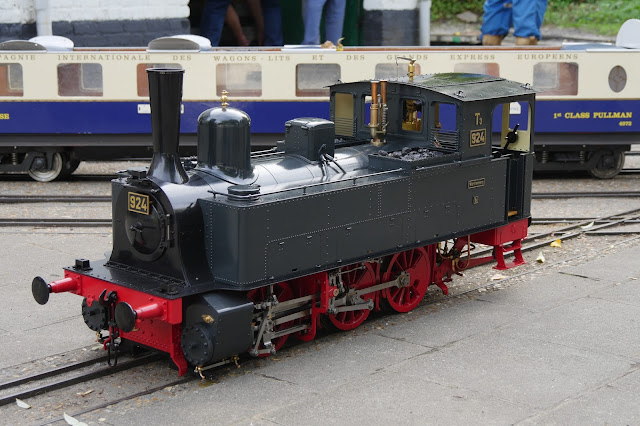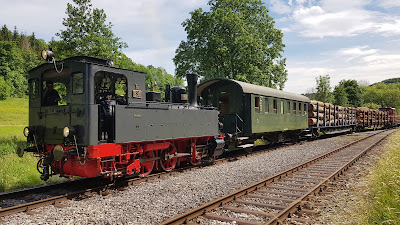The choice of the Model
The locomotive
This project started in august 2006 and will be published on this website as progress gets along. The locomotive is a 7¼" gauge live steam model of a German Württembergische T3 (0-6-0) which I'm designing with the aid of 3D cad software and building in my workshop.
The complete CAD file of the loco and wagons can be downloaded for free from:
At Petit Train Vapeur Forest in Brussels in October 2018 (Photo by Arif Kavak)
Even on this scale (1:8), it is a quite small loco, with the benefit that it can be handled in my home workshop and will fit in the boot of my car. A larger loco on 7¼" gauge would be too much for my small workshop. And in my opinion, most model live steam tracks in the Netherlands have the size of a branch line rather than the main line.
The finished model is on track at Barendrecht on 6 May 2018
Testing the loco on a two-day steam event; click here for a full report
My son Martin is happy with the result so far. The locomotive was taken to the track of PTVF in Brussels on October 2017; the first real test on the track after 11 years of construction.
Still not fully completed; a working steam pump and some details such as a builder's plate on the dome and glazing are to be made. The loco lamps need a bit of detailing and must be painted before they can be put on the loco.
Earlier the 7¼" model, as it was in May 2015 at Turnhout (Belgium) ; The running gear, cab, tanks, and boiler are complete. Boiler cladding and pipework had to be made. You'll find the progress of the locomotive on the blogs of this website.
The works photo from the manufacturer. They were built at the locomotive works in Esslingen and Heilbronn for the Königlich Württembergische Staats-Eisenbahn between 1891 and 1913. The loco I'll be building has the running number 924 and was built in 1907 by Maschinenbau Gesellschaft Heilbronn with works number 489. German locomotives we usually not named.
110 examples in total were built, and four of them are preserved.
Although the small size of this loco there are several 7¼” gauge versions of the Prussian T3 and they are all very good performers on the track. Prussian T3's are in main dimensions very similar to this Königlich Württembergischen Staatseisenbahnen (KWStE) version and, as in real live, these is also derived from the Prussian T3. Here you see the Prussian T3 of Thomas Adler on 7¼ gauge
The model with an overall length of just under 1.10 meters and a weight of around 100kg, should be able to do some work on a ground-level track and it still can be transported in our family car.
The choice of the model
It all started with the plan to build a small Stroudley Terrier A1 class 0-6-0 loco called New Port and designed by Don Young. A nice little engine on 7.25" gauge (184mm) as the next project after the 'Didcot'.
The wheel castings for this loco were (and still are) however exceptionally expensive at Reeves2000. Over 600,-- Euro for six wheels, ex. postage & package.
The wheel castings for this loco were (and still are) however exceptionally expensive at Reeves2000. Over 600,-- Euro for six wheels, ex. postage & package.
I was talking about this with a German model engineer, whom I'd met at the annual steam meeting in Den Haag Zuiderpark. Wolfgang told me he had some wheel castings, drawings, cylinders, chimney, and lots of other bits and pieces for a German 7.25" gauge T3 (see this video) he was not using anymore.
An appointment was quickly made and within a few weeks, I was the proud owner of a complete set of castings for a 7.25" gauge locomotive. The drawings and castings came from Live Steam Service.
An appointment was quickly made and within a few weeks, I was the proud owner of a complete set of castings for a 7.25" gauge locomotive. The drawings and castings came from Live Steam Service.
This Prussian T3 is a very nice loco indeed, but in a small book, I read about a variation on this design, the so-called Württembergische T3 (89 3-4). All the parts could be used, only a new drawing had to be made. This gave me the opportunity to incorporate some ideas from earlier experiences with previous model locomotives and to get some hands-on experience with 3D solid modeling software like Inventor and Solid works.
Foto by Harald Frank
The preserved Württemberigsche T3 930
Drawing and designing were done in 3D CAD software. This was a great aid during design and construction.
Also, data from the drawings could be used for laser cutting and CNC milling.
Drawing and designing were done in 3D CAD software. This was a great aid during design and construction.
Also, data from the drawings could be used for laser cutting and CNC milling.
I started the frame in Inventor 2006. This started the locomotive.
The general view in Inventor; most general dimensions were actually taken from the Brawa H0 scale model.
A switch to Solidworks 2007 was made; this was the software we were starting to use at our university of applied science (Fontys Eindhoven) and it gave me the opportunity to learn Solidworks 'on the job'.
A general arrangement of the T3, with the original short side tanks. These were later extended towards the smokebox.
A very nice model in 0 gauge (1:45) by Fritz Müller.
I've started with the very good book "Die Baureihe 89 3-4" by Werner Willhaus (EK-Verlag),
which includes a few very clear drawings and plenty of photographs of the locomotive during its
existence. The first was built in 1891 for the Königlich Württembergische Staatseisenbahnen
(K.W.StE). Luckily a few locos of this class are still preserved in Germany.
which includes a few very clear drawings and plenty of photographs of the locomotive during its
existence. The first was built in 1891 for the Königlich Württembergische Staatseisenbahnen
(K.W.StE). Luckily a few locos of this class are still preserved in Germany.
Testing the frame at the track of the SMMB in Tilburg in March 2011
At the Voorjaarsstoomdag of Stoomgroep Zuid in Loon op Zand, March 2012 (photo by Eric Bruinewoud)
This is the annual model engineering exhibition of Stoomgroep Zuid, of which I'm a member.
This is the annual model engineering exhibition of Stoomgroep Zuid, of which I'm a member.
At Stoomgroep Stormpolder on June 2012
One of the preserved Württembergische T3 no. 930 was back in steam on September 2013
The newly restored Wü T3 no. 930 in steam in 2014. To see this loco in steam: click here
May 2015
The Solidworks drawing of the locomotive (as it is) can now be downloaded here at
The almost completed T3 is standing at the station sidings.
In my workshop the locomotive is big, but once on the track is only a small engine.
The H0 and gauge 1 set
The first steaming of the loco on 17 September 2017
Breda 17 September 2017
Brussels at the PTVF October 2018
Read all about the construction of this locomotive on this blog.
Stuttgarter Hofbräu Bierkühlwagen. Finished in April 2021. Read all about this beer wagon HERE
The Märklin train set at Stoomgroep Limburg (Brussum NL) 27th June 2021
The real locomotive
On 27th June 2021, the real Württembergische T3 made its first appearance in the new black-grey livery.
In Germany (Münsingen) the locomotive is now painted in the same RAL 7021 Schwartz-Grau color as my model.
The Schwäbische Alb Bahn contacted me about the livery of my model and which sources
I used it to determine the color. I pointed them to the websites and books I've found and they
decided to use the black-grey livery as well.
So in this case the model of the loco is the example for the real one. The extra windows in the cab front are now also incorporated into the real loco.
With the kind permission of Manuel Walker, I hereby publish the photos of the T3.
T3 at Müsingen station (Germany)
Click below for a direct link to start of construction series of:


















.jpg)
+.jpg)



































